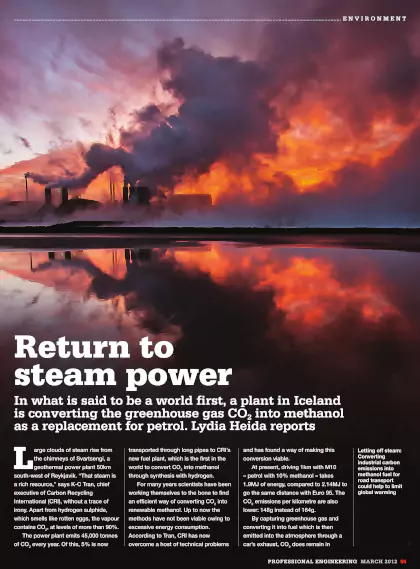Return to steam power
In what is said to be a world first, a plant in Iceland is converting the greenhouse gas CO2 into methanol as a replacement for petrol.
Large clouds of steam rise from the chimneys of Svartsengi, a geothermal power plant 50km south-west of Reykjavik. “That steam is a rich resource,” says K-C Tran, chief executive of Carbon Recycling International (CRI), without a trace of irony.
Apart from hydrogen sulphide, which smells like rotten eggs, the vapour contains CO2, at levels of more than 90%.
The power plant emits 45,000 tonnes of CO2 every year. Of this, 5% is now transported through long pipes to CRI’s new fuel plant, which is the first in the world to convert CO2 into methanol through synthesis with hydrogen.

Viable conversion of CO2
For many years scientists have been working themselves to the bone to find an efficient way of converting CO2 into renewable methanol. Up to now the methods have not been viable owing to excessive energy consumption. According to Tran, CRI has now overcome a host of technical problems and has found a way of making this conversion viable.
At present, driving 1km with M10 – petrol with 10% methanol – takes 1.9MJ of energy, compared to 2.14MJ to go the same distance with Euro 95. The CO2 emissions per kilometre are also lower: 148g instead of 164g.
By capturing greenhouse gas and converting it into fuel which is then emitted into the atmosphere through a car’s exhaust, CO2 does remain in circulation.
This may not decrease the quantity of greenhouse gas in the atmosphere but, by reusing it, petroleum companies need to pump up less oil from out of the ground. This is ultimately what will decrease the amount of greenhouse gas in the atmosphere.
Efficient reaction
CRI had to develop several technological innovations to make the conversion of CO2 to fuel viable. But nature has also given a helping hand. The greatest advantage of being in Iceland is that the captured CO2 comes from a geothermal reservoir and so contains few impurities.
The only disadvantage is that the CO2 still contains about 5% hydrogen sulphide, although this is easy to remove in a system of absorption and adsorption.
Carbon dioxide has the undesirable quality that at the molecular level it is difficult to put into motion, and doing so devours energy. “We first had to find an efficient reaction to combine CO2 with hydrogen and then to compress it,” explains Tran.
The hydrogen is produced by electrolysis of geothermal water, a process that also uses much energy. The syngas so obtained is converted into methanol by means of a copper-based catalyst. This syngas is usually derived from carbon monoxide (in the Fischer-Tropsch process), which is why current catalysts are set up for this process.
Competitive price
CRI developed a new catalyst that is sensitive to CO2 while not creating undesirable byproducts such as methane. “This was the most challenging aspect of the project,” says Tran.
During this research phase, CRI received support from Professor George Olah, winner of the Nobel Prize for Chemistry in 1994. The new plant has been named after Olah.
An extra plus point is that CRI’s factory runs on geothermal energy, a renewable source that is very cheap in Iceland. So the company produces fuel that is both cheap and green.
“As long as the price of a barrel of crude oil is above $55, our methanol will compete with ordinary fuel,” smiles Tran. (...)
Publication: Professional Engineering Magazine
Date: February 2012
Would you like to read the entire article? If so, please let me know!
CONTACT MENanomaterials: a new threat to the recycling industry?
Read More

Can waterless dyeing processes clean up the clothing industry?

Money to burn
Interested in working together?
I'd love to hear from you.